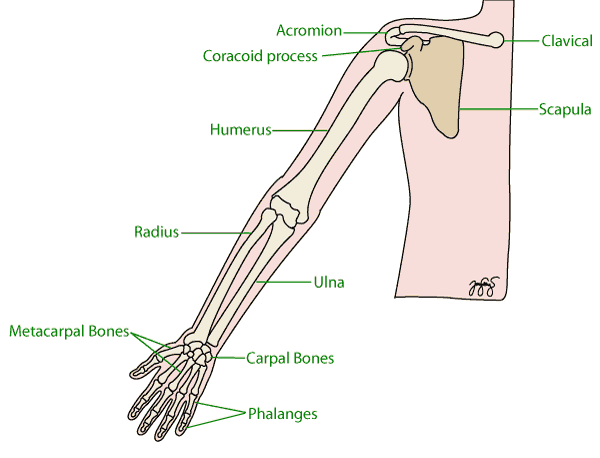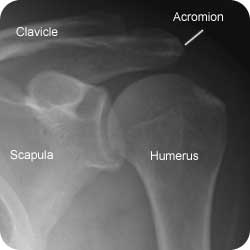What is a broken arm?
A broken arm may involve any of the three bones in your arm — the ulna, radius and humerus. In Orthoanswer, these are divided into:
- Broken Wrist
- Broken Elbow
- (and Fractures of the Radial Head near the elbow, and Fractures of the Olecranon)
- Broken lower arm (forearm)
- Broken upper arm
In general, fractures in the arm will require several weeks in a sling or cast. During this time, you may be asked to avoiding weight-bearing (lifting or carrying with your injured arm), and may need to keep the arm elevated to keep down the swelling.

Symptoms
Having a broken arm is a very painful experience and most people know right away if they break their arm.
If the break is severe, there is often a loud cracking sound. However, sometimes it is difficult to tell the difference between a sprain, a dislocation or a fracture.
The signs and symptoms of a broken (fractured) arm include:
- Severe pain, which is worse with movement
- Swelling and Bruising
- Deformity, such as a bent arm or wrist
- Impaired movement, inability to move or rotate your arm, wrist or elbow
Causes
Common causes for a broken arm include:
- Falls. Falling onto an outstretched arm is the most common cause of a broken arm.
- Sports injuries. Direct blows and injuries whilst playing sport are a common cause of all types of arm fractures.
- Car and Motorbike Accidents. These injuries can be very severe and often require surgery.
Risk Factors
Contact sports and Winter sports
Contact sports are more likely to lead to fractures than non-contact sports. These include:
- Basketball
- Football
- Rugby
- Hockey
- Soccer
Winter sports are also are common cause of broken bones
- Snowboarding
- Skiing
Osteoporosis
Osteoporosis is a condition in which bones become thinner and more brittle, making them weaker and much easier to break. So even a relatively minor fall can result in a broken arm.
The common areas that people with osteoporosis break their bones include:
- Wrist (distal radius)
- Shoulder (surgical neck of humerus)
- Hip (neck of femur)
Investigations
X-rays
Most arm fractures can be diagnosed by X-ray.
On most occasions, your doctor can treat your fracture based on an Xray, without the need for further specialised scans.
Sometimes in very subtle fractures, the fracture may not be visible immediately and can only be seen on a repeat Xray a few weeks later when the bone has started healing.

A Xray of the Left Shoulder showing normal anatomy
CT Scan
Sometimes a CT scan is needed to show more detail of the fracture, especially if your fracture involves your joint.
A CT scan takes X-rays from many different angles and then a computer combines the images to show cross-sectional and 3D images of your bones.
Complications
The complications of having a broken arm depends on the type, location and severity of your fracture. In general terms, a broken arm can lead to:
- Stiff joint. If a fracture is near or involves a joint, it can lead to a stiff joint with a reduced range of movement. For example, an elderly person with an osteoporotic fracture of the shoulder often is unable to reach as far above the head or around the back as they use to, even if the fracture has healed well.
- Poor healing. A fracture which is slow to heal is called “delayed union”, whilst a fracture that has failed to heal is called “nonunion”.
- Damage to nerves and vessels.
- Arthritis. A fracture that involves the joint can lead to arthritis of that joint.
- Weakness.
Treatment
Treatment for a broken arm depends on the exact site and severity of the injury.
- Sling. A simple break may be treated with a sling, ice and rest.
- Plaster Cast. Some breaks need a plaster cast to hold the fracture in the correct position whilst it heals. Some useful links on Orthoanswer:
- Caring for your Cast
- Kids and Broken Bones
- Manipulation and Plaster Cast. If your fracture is not in the right position (displaced) it may need to be manipulated or straightened. This usually involves a local or regional anaestheticto numb the arm or a general anaesthetic to put you asleep. After your fracture has been manipulated, a plaster cast is applied.
- Surgery. In some cases, your may need on operation to fix your fracture. An orthopaedic surgeon may need to use plates, screws or nails to hold your fracture in the correct place whilst it heals.
Physiotherapy
After your bone has healed, a physiotherapist can teach you exercises to improve your flexibility and strength.
Seeking Advice
Your Family Doctor (GP)
Your Family Doctor is a great place to start to to diagnose and help treat your problem. He or she will be able to
- tell you about your problem
- advise you of the best treatment methods
- prescribe you medications
- and if necessary, refer you to Specialists (Consultants) for further treatment
Emergency Department
The doctors in the Emergency Department can diagnose and treat many of the arm fractures. If the pieces of broken bone aren’t lined up properly to allow healing with immobilisation (e.g. a plaster cast), you may be referred to an Orthopaedic Surgeon.
Bring along information about yourself
It can be a great help for your doctor if you bring along the following information about yourself
- A list of your medications, including the name and dosage.
- Information about your medical problems and past treatment
- Previous investigation results, such as xrays and blood tests.
Prevention
- Exercise. Weight bearing exercises to build your bone strength.
- Build bone strength. Maintain a healthy diet including calcium-rich foods, such as milk, yoghurt and cheese.
- Wear Protective Braces.
